The
Normal Equine Estrous Cycle
 64-66 64-66

- The normal estrous cycle in the mare is 21 to 22 days
long, as defined by the intervals between ovulation. The duration of
estrus, however can vary, so the most consistent period in the estrous
cycle is the length of diestrus.
Diestrus has a fairly consistent 14 day
(hormonal) or 15 day (behavioral) duration. Estrus
Estrus is the time the mare is "hot" ,
"in" ,or "standing" It is the "follicular
phase", as the overt signs of estrus are attributable to the
estrogen production by the follicle on the ovary.
The duration is
normally considered to be 7 days, but the duration actually varies with
time of year.
The duration of estrus is inversely proportional to day
length, which means it becomes shorter at the peak of the cycling
season.
Signs
- The mare will
show interest in the stallion, and may actually seek out a stallion when
she is in estrus.
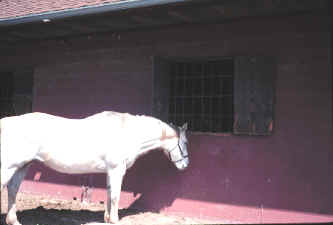
Stallion is
in the window.
- The mare will move her ears
forward, elevate her tail, squat to urinate (termed "breaking
down"), evert the clitoris (termed "winking") and accept
the stallion for breeding.
- Some mares may not
show sexual receptivity (See "aberrations of the cycle").
Ovulation
- Ovulation
is often said to occur on about day 5 of cycle, or 1 to 2 days before
end the of estrus.
- This can be confusing as the duration of estrus
changes during the season, and the mare does not base when to ovulate on
when she anticipates going out of estrus.
- A better way to state when
ovulation occurs is that the mare goes out of heat 1 to 2 days after
ovulation. This makes much more sense in that after ovulation the
follicle is a CH and is not producing estrogen, therefore the mare will
not show signs of heat after ovulation.
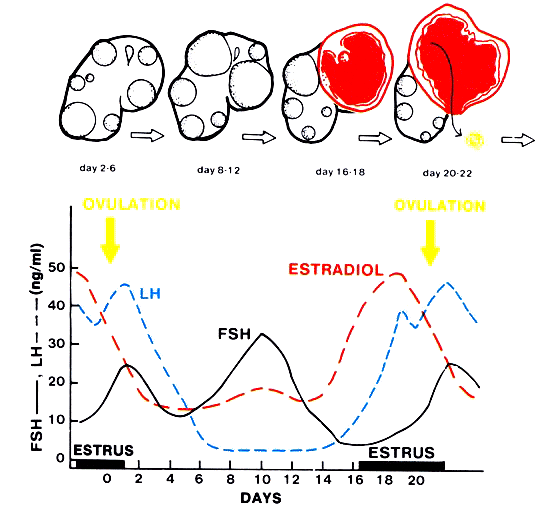
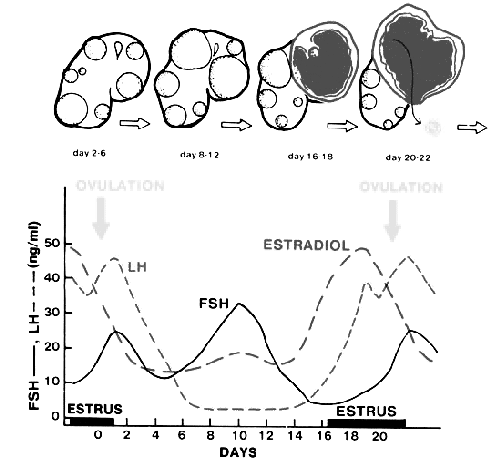
Diestrus
Diestrus is called "cold", "out",
or the luteal phase, since it is dominated by progesterone produced by
the corpus luteum.
The duration of diestrus is a consistent 14 -15 days.
When counting days in a mare's cycle, it is best to start counting the
day the mare goes out of heat and count forward 14 -15 days to predict when
she will next come into heat. In this way you can anticipate when the
next heat will be better than counting the traditional 21 days.
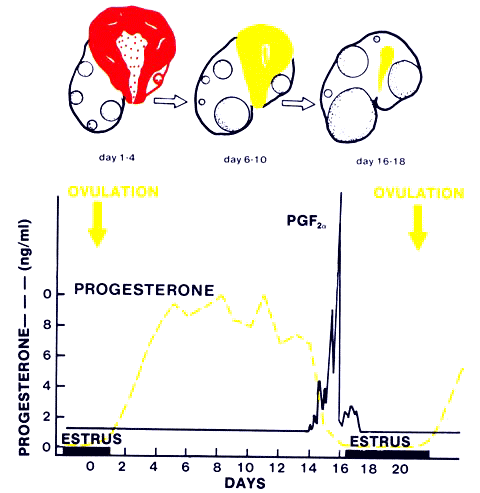
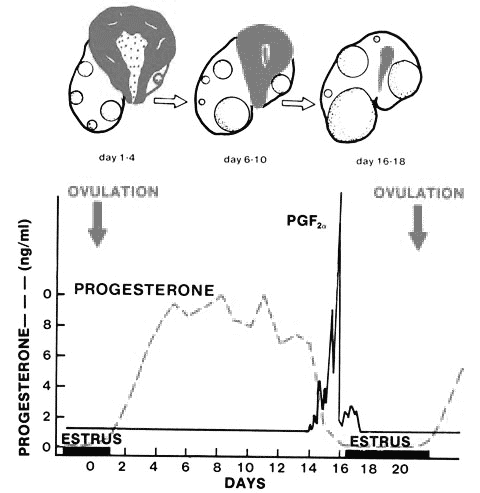
-
Signs
- During
diestrus the mare rejects the stallion's advances. She
does this by pinning her ears back and kicking at the stallion.
There is really no
metestrus or proestrus during the equine estrous cycle.

Click here to see
a
video
of
mare
teasing.
Hormonal Events of the
Estrous Cycle
- FSH
-
FSH is responsible for the growth of new follicles,
granulosa cell multiplication and LH receptor induction.
-
The timing of
FSH is somewhat odd in that it actually peaks during diestrus.
-
This
causes 1-2 waves of follicular growth.
-
The first wave usually starts to
grow about 9 days after ovulation. This first wave may be the only
dominant follicle or another dominant follicle wave may arise.
-
Inhibin
- Inhibin
is a protein produced by the granulosa cells of the dominant follicle.
-
Inhibin inhibits further FSH production and therefore inhibits the
growth of new follicles.
- In a sense, the
dominant follicle ensures selection of itself over all other follicles
by preventing their growth.
-
LH
- LH rises
at the beginning of estrus and, unlike in other species, peaks 2 days
post ovulation.
- In the mare, LH has a long
half-life due to the sialic acid residues present.
- The
final follicular rescue is LH dependent and the secretion of LH is
modulated by endogenous oxytocin in estrus.
- Repeated oxytocin
administration or sexual stimulation may induce an LH peak and thereby
enhance the ovulatory surge.
-
Progesterone
- Progesterone
is from the transformed granulosa cells (or thecal cells in the mare)
and rises shortly after ovulation. It is the dominant hormone of
diestrus.
-
Prostaglandin
- Prostaglandin
is produced by the endometrium when there is no pregancy signal by the
early embryo.
- Prostaglandin enters
the systemic circulation via A-V or
lymphatic transfer (the mare lacks the local countercurrent exchange
mechanism seen in the cow) and causes lysis of the mature corpus luteum.
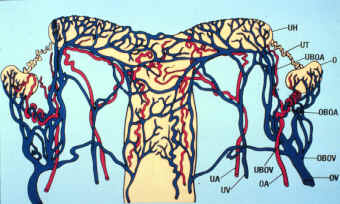 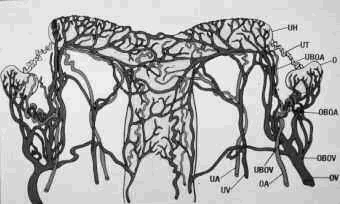
-
The corpus luteum is responsive to prostaglandin
about 5 days after ovulation (but may be sooner or later).
- If the
endometrium is damaged, there may be no prostaglandin production, so the
mare may not return to estrus regularly.
- Prostaglandin
can be released by cervical stimulation, intrauterine infusions, biopsy,
culture, or endometritis. This will result in a premature return to
estrus.
|